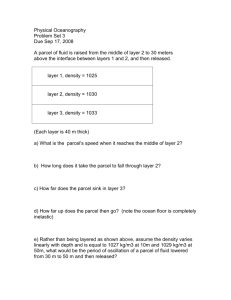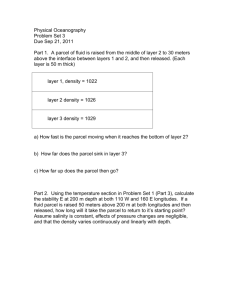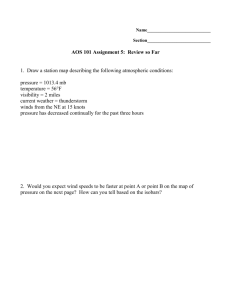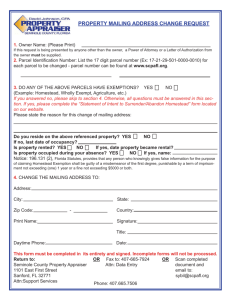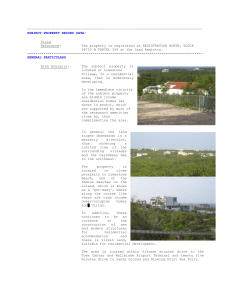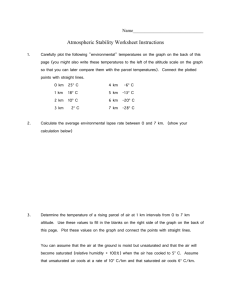Forty Years of Land Use and Land Oak Woodlands
advertisement
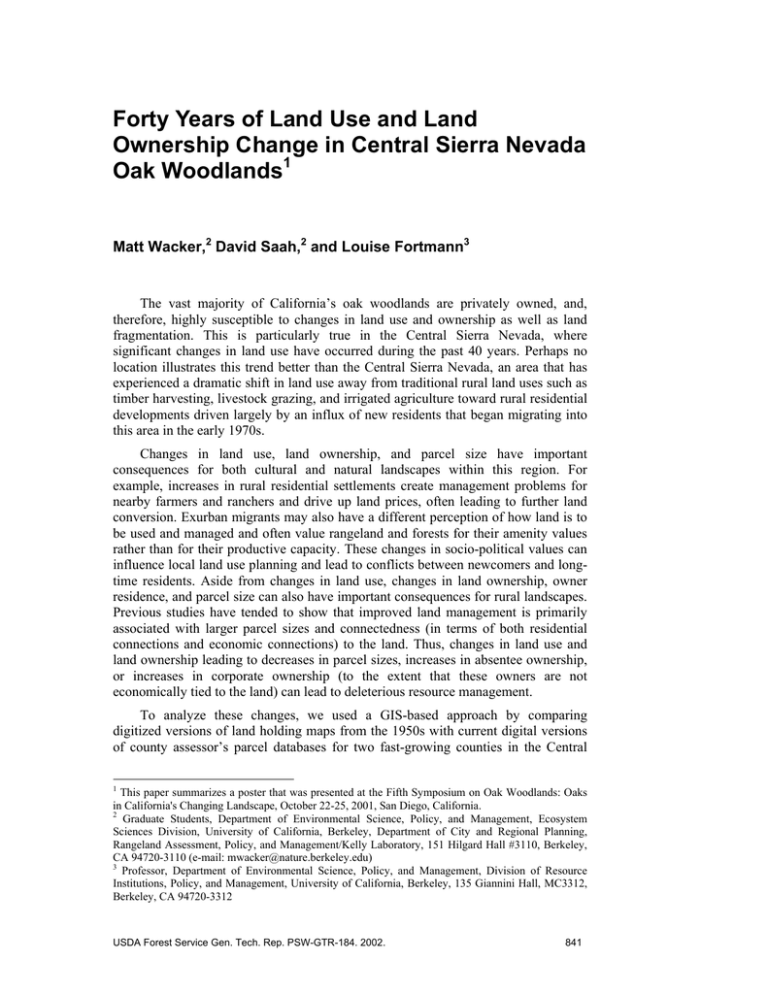
Forty Years of Land Use and Land Ownership Change in Central Sierra Nevada Oak Woodlands1 Matt Wacker,2 David Saah,2 and Louise Fortmann3 The vast majority of California’s oak woodlands are privately owned, and, therefore, highly susceptible to changes in land use and ownership as well as land fragmentation. This is particularly true in the Central Sierra Nevada, where significant changes in land use have occurred during the past 40 years. Perhaps no location illustrates this trend better than the Central Sierra Nevada, an area that has experienced a dramatic shift in land use away from traditional rural land uses such as timber harvesting, livestock grazing, and irrigated agriculture toward rural residential developments driven largely by an influx of new residents that began migrating into this area in the early 1970s. Changes in land use, land ownership, and parcel size have important consequences for both cultural and natural landscapes within this region. For example, increases in rural residential settlements create management problems for nearby farmers and ranchers and drive up land prices, often leading to further land conversion. Exurban migrants may also have a different perception of how land is to be used and managed and often value rangeland and forests for their amenity values rather than for their productive capacity. These changes in socio-political values can influence local land use planning and lead to conflicts between newcomers and longtime residents. Aside from changes in land use, changes in land ownership, owner residence, and parcel size can also have important consequences for rural landscapes. Previous studies have tended to show that improved land management is primarily associated with larger parcel sizes and connectedness (in terms of both residential connections and economic connections) to the land. Thus, changes in land use and land ownership leading to decreases in parcel sizes, increases in absentee ownership, or increases in corporate ownership (to the extent that these owners are not economically tied to the land) can lead to deleterious resource management. To analyze these changes, we used a GIS-based approach by comparing digitized versions of land holding maps from the 1950s with current digital versions of county assessor’s parcel databases for two fast-growing counties in the Central 1 This paper summarizes a poster that was presented at the Fifth Symposium on Oak Woodlands: Oaks in California's Changing Landscape, October 22-25, 2001, San Diego, California. 2 Graduate Students, Department of Environmental Science, Policy, and Management, Ecosystem Sciences Division, University of California, Berkeley, Department of City and Regional Planning, Rangeland Assessment, Policy, and Management/Kelly Laboratory, 151 Hilgard Hall #3110, Berkeley, CA 94720-3110 (e-mail: mwacker@nature.berkeley.edu) 3 Professor, Department of Environmental Science, Policy, and Management, Division of Resource Institutions, Policy, and Management, University of California, Berkeley, 135 Giannini Hall, MC3312, Berkeley, CA 94720-3312 USDA Forest Service Gen. Tech. Rep. PSW-GTR-184. 2002. 841 Forty Years of Land Use and Land Ownership Change in Central Sierra Nevada Oak Woodlands— Wacker, Saah, and Fortmann Sierra, Placer and El Dorado. Unfortunately, our choice of study area was constrained somewhat by the availability of historic land use and land ownership datasets which limited our ability to include many areas of the greatest amount of land use change in these counties. For Placer County, the study area extended from Highway 49 on the west to the crest of the Sierra Nevada on the east; in El Dorado County, the study area extended from 121 degrees west longitude (approximately a north-south line running just west of Latrobe) to the western edge of the El Dorado National Forest at approximately 120.5 degrees west longitude. Because of these differences, the Placer study area contained significantly less oak-dominated rangeland than the El Dorado study area and more Federally owned coniferous forest. For our historic dataset, we used data originally collected by UC Berkeley researcher Dennis Teeguarden to analyze private forest ownership attributes in 1957. This data was collected by running north-south transects through the study area at approximately two-mile intervals in privately owned lands and three-mile intervals in Federally owned lands. Parcel intersection points were recorded along each transect and a set of owner attributes, including owner occupation, owner residence, and owner name were recorded for each sampled parcel. These transect and parcel sample point maps were digitized and incorporated into a Geographic Information System. Current landowner attributes were collected from digital versions of county assessor’s parcel maps and intersected with the digitized Teeguarden sample transects to obtain a second GIS coverage. Through this procedure we were able to obtain two arc-based GIS datasets, one for 1957 and one for the present day, where the nodes of each arc represented the top and bottom intersection points of a parcel polygon. Using these datasets, arc length and arc count comparisons were made among different classes of land use, landowner residence, and type of landowner to assess the extent of land use and land ownership change as well as the extent of parcel fragmentation in the study areas. Results indicate a large decrease in the amount of land devoted to agriculture and forestry in both counties. In Placer County, land devoted to agriculture, which included both grazing land and farmland, declined from 3.5 percent to 0.25 percent while in El Dorado County farmland declined slightly from 5.6 percent to 5.2 percent but grazing land dropped sharply from 41.5 percent to 5.8 percent of the study area. Land devoted to forestry decreased from 28.3 percent to 18.4 percent in Placer and from 11.4 percent to 8.7 percent in El Dorado. These decreases in rural land uses were coupled with an increase in land devoted to other, primarily residential land uses. In Placer County, these lands increased from 68.1 percent to 81.1 percent; the increase was even more pronounced in El Dorado where other land uses increased from 41.5 percent to 81.2 percent. In terms of land ownership, the most notable trends were an increase in Federal ownership and a drop in “other” (non-business) ownership within Placer County. El Dorado County also saw a drop in “other” ownerships, but, as opposed to Placer County, owners classified as businesses increased sharply. Owner residence was largely unchanged in El Dorado County while absentee ownership declined and Federal ownership increased in Placer County. Parcel size changes were characterized by marked fragmentation of land holdings across all land uses, ownerships, and owner residences in both counties. Given these results, it appears that grazing lands in the western portion of El Dorado County have experienced the greatest amount of parcel fragmentation and land use conversion. Equally significant has been the increase of business ownership of rangelands in western El Dorado County, primarily by land developers and 842 USDA Forest Service Gen. Tech. Rep. PSW-GTR-184. 2002. Forty Years of Land Use and Land Ownership Change in Central Sierra Nevada Oak Woodlands— Wacker, Saah, and Fortmann speculators who likely intend to convert these lands to residential uses in the future. The study area within Placer County has become increasingly characterized by Federally owned or locally owned, “other” lands (residential/recreational), both situations that would tend to retard future land use change. Additional studies are currently underway to determine how past changes in land use and land ownership have affected vegetation composition and transitions between various vegetation states at the landscape scale from the 1950s to the current day. By better understanding the relationship between land use and vegetation change, we hope to inform planners charged with regulating land use in Sierra Nevada oak woodlands of the likely consequences of poorly-planned rural residential growth and future land use change in the region. USDA Forest Service Gen. Tech. Rep. PSW-GTR-184. 2002. 843
